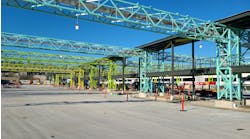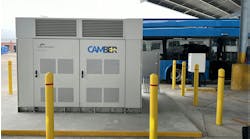Link Transit completes installation of 300 kW wireless inductive bus chargers
Link Transit has installed three new Momentum Dynamics 300 kW in-ground inductive chargers to support its current fleet of 10 BYD K9S 35-foot battery-electric buses.
The installation comes nearly 12 years after Link Transit received its first federal grant for the purchase of electric buses and will support Link Transit’s 11-vehicle expansion that is currently underway.
The addition of these wireless chargers to the Link Transit service will allow Link Transit to extend the range of its battery electric buses from their current 190-mile range to more than 300 miles per day. An existing 200 kW unit that has been in operation since March 2018 will be upgraded to the new technology this August. Prior to the use of wireless inductive charging, buses were slow charged overnight and able to operate only a partial day of service.
Link Transit operates 10 battery electric buses in daily service on the routes running in the Wenatchee, Wash., and East Wenatchee area. These buses run 200-plus miles each day, so having the ability to re-energize the batteries while in service throughout the day for five to seven minutes at a time keeps the batteries at optimal charge levels and provides a range of more than 300 miles.
Two additional 30-foot BYD coaches will be added to the fleet later this summer, and three more in late 2022. This will allow all of Link’s urban service to be operated by battery electric buses, as well as for some limited longer distance routes.
“We are beyond pleased with how this technology has been functioning for us,” said Richard DeRock, Link general manager. “Reliability in varying weather and temperature conditions has been excellent, and we are confident that we can operate these vehicles with the consistency necessary to deliver a great service to the residents of our communities.
“Additionally, here in the Wenatchee area, due to our abundant carbon free hydro power, we have the additional benefit of delivering emission and carbon free transit that is less costly than operating current diesel-powered transit buses,” DeRock added
An event to celebrate the culmination of Link’s battery electric bus project and the Green Transportation Grant bus and car charger project will be held Aug. 19 at Link’s transit center in Wenatchee.
Link Transit has been working on operating battery electric buses for nearly 12 years, beginning with the award of a $2.93 million TIGGER grant in 2009 that funded the purchase of five, 22-foot trolley style buses and two high powered robotic chargers from eBUS in Downey, Calif. These vehicles operated with a variety of battery chemistries and other changes to technology from 2010 until 2017 when excessive failures and the unavailability of critical components forced them to be removed from service.
In 2016, Link Transit, using a $2.5 million Federal TIGGER Grant ordered five BYD 35-foot transit coaches with delivery taking place in early 2017. These vehicles failed to meet Link Transit’s minimum specifications when the ambient temperatures exceeded 95 degrees or were below 32 degrees.
Link Transit notes BYD stepped forward and agreed to replace these buses with five new vehicles that incorporated a newly designed, active battery temperature management system. Link Transit then ordered, utilizing an FTA $3.2 million No/Lo grant, five more of these advanced designed coaches and the wireless 200 kW vehicle charger. These 10 advanced design buses, which were put into service in December 2019, are the buses that Link Transit operates today.
In 2019, Link Transit was awarded a State of Washington Green Transportation Grant for $1.4 million for the purchase of three wireless 300 kW Bus chargers, seven plug-in 85 kW overnight bus chargers, 19 Level 2 personal car chargers for public use in Link Transit Park and Rides and other electrical infrastructure to support vehicle electrification. The recent installation of this equipment marks a milestone in Link’s efforts to electrify public transportation in Chelan and Douglas Counties.


